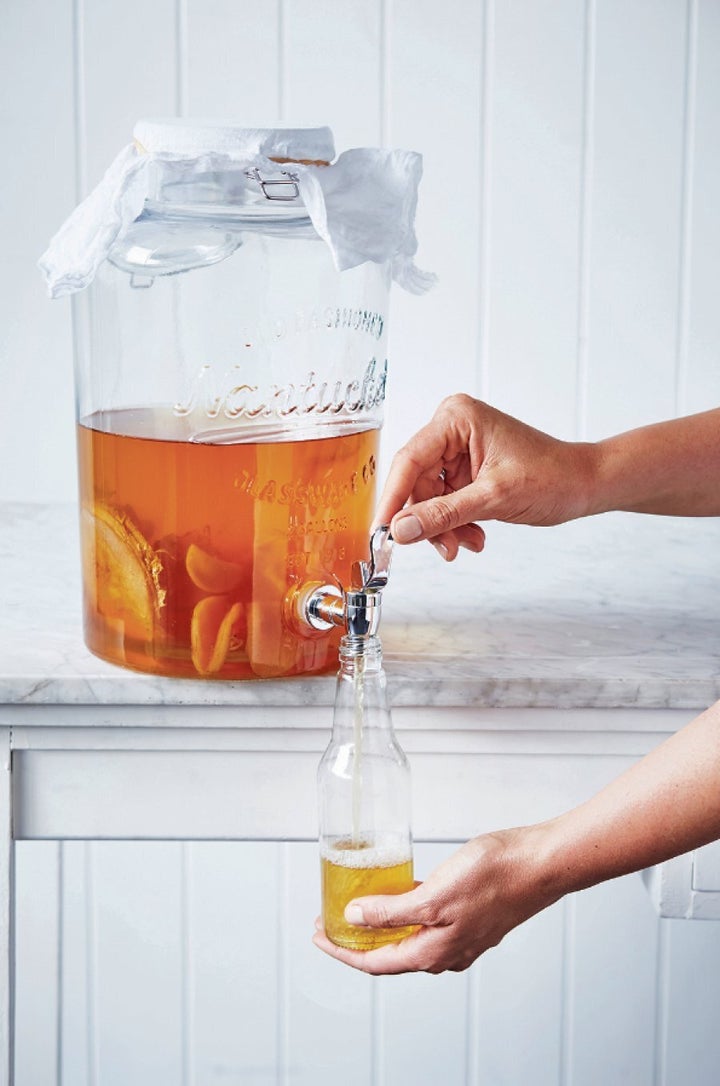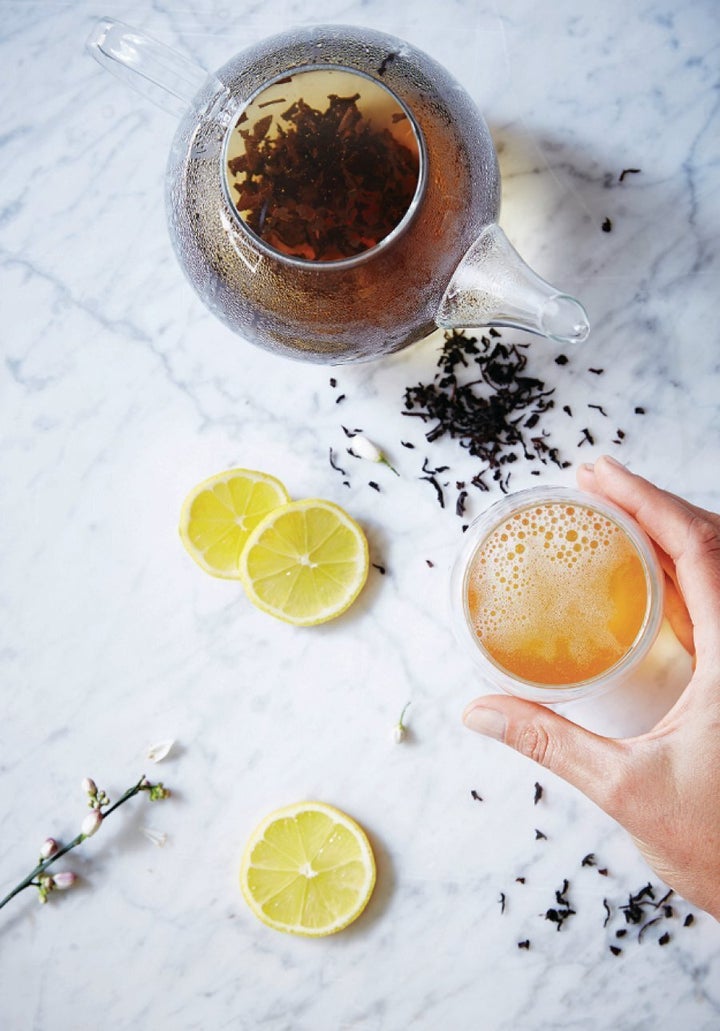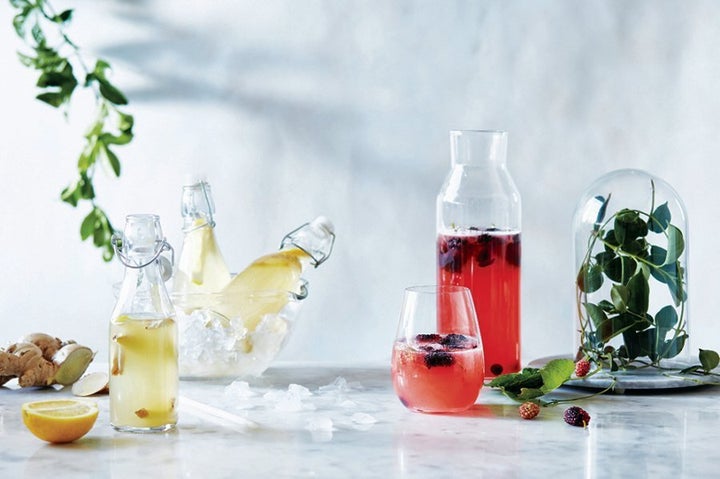If you're all about that gut health, then probiotic drinks like kombucha and kefir are no strangers to you. These unique, tasty drinks 'feed' the good bacteria in your gut, which can help promote a healthy digestive tract and immune system.
Thanks to their popularity, you can find probiotic drinks in every health food store and even supermarkets. But the main downside to these gut-friendly drinks? Their price tag.
Good news: you can make your own kombucha and kefir at home. All you need are simple ingredients like tea, sugar and water, along with your starter cultures (which you can get online or from a friend) and flavouring ingredients of your choice.
Try these three recipes for basic kombucha, Earl Grey kombucha with lemon, and water kefir from Probiotic Drinks at Home by Felicity Evans.

1. Basic kombucha
In kombucha brewing, the sugars convert into acids, leaving a low-sugar drink.
I like to harvest the kombucha when it's still a little sweet. However, if you want to make a vinegar or a totally sugar-free product, allow it to ferment for several weeks and use the kombucha vinegar in salad dressings.
Preparation time: 15 minutes. Fermentation time: 1–5 weeks. Difficulty: medium. Shelf life: refrigerate for up to three months.
Makes: About one litre (four cups).
INGREDIENTS
- 1 litre (4 cups) filtered water or springwater
- 4 black tea bags or 1 tablespoon loose-leaf black tea
- 3 tablespoons raw or white sugar
- 3 tablespoons kombucha starter culture liquid
- 1 kombucha Mother, a little smaller than the size of your palm
Primary fermentation:
- Bring 500ml (2 cups) of the filtered water to a simmer. Pour into a teapot or heatproof bowl, add the tea bags or tea leaves and leave to steep for 3–5 minutes. Strain the tea into a heatproof 1.5 litre (6-cup) wide-mouth glass jar and discard the tea bags or tea leaves. Add the sugar to the jar and stir to dissolve. Pour in the remaining filtered water.
- When the liquid has cooled to room temperature, add the kombucha starter culture liquid and Mother. Cover the jar with a piece of muslin (cheesecloth) and secure with an elastic band.
- Place the jar out of direct sunlight in a cool spot where it won't be disturbed. Leave the liquid to ferment for around four days in hot weather and 14–20 days in cooler weather.
Bottling:
- Gently remove the Mother to re-use or rest (in a sugar-tea solution in the fridge). Retain three tablespoons of the kombucha liquid as the starter culture liquid for your next brew.
- Mix in any sediment that has settled at the bottom of the jar, or leave it as it is. Put a funnel in the opening of a 1 litre (4-cup) glass bottle with a tight-fitting lid and put a strainer on top of the funnel. Pour the kombucha into the bottle through the strainer and discard any solids.
Secondary fermentation:
Tightly seal the bottle lid and leave the bottle on the bench to build carbonation. This could take anywhere from 2–14 days, depending on the temperature. 'Burp' the kombucha daily to release some pressure by opening the lid slightly and then tightening it again.
Drink up:
When the kombucha is as fizzy and sour as you like (this could range from a small spritz to a ferocious fizz), store it in the fridge to slow the fermentation process, and enjoy cold.

2. Earl Grey kombucha with lemon
The defining feature of Earl Grey tea is the addition of bergamot oil, which is the cold-pressed oil from inside the rind of the bergamot orange. The bergamot orange is known as 'sour orange', which tastes more bitter than a grapefruit but less sour than a lemon.
Preparation time: 15 minutes. Fermentation time: 1–5 weeks. Difficulty: medium. Shelf life: refrigerate for up to three months.
Makes: About one litre (four cups).
INGREDIENTS
- 1 x basic kombucha ingredients (above); replace the black tea with Earl Grey tea
- ½ lemon, juiced
Primary fermentation:
Follow the instructions for basic kombucha, using Earl Grey tea instead of black tea.
Bottling:
Follow the instructions for basic kombucha.
Secondary fermentation:
- Squeeze the lemon juice into the bottle and tightly seal the lid. Leave the bottle on the bench to build carbonation. This could take anywhere from 2–14 days, depending on the temperature.
- 'Burp' the kombucha daily to release some pressure by opening the lid slightly and then tightening it again.
Drink up:
When the kombucha is as fizzy and sour as you like, store it in the fridge to slow the fermentation process, and enjoy cold.
Tip: The bergamot oils in fragrant Earl Grey could, over time, decrease the effectiveness of the Mother. I recommend using this recipe when you have a back-up Mother. It's best to rotate this kombucha with the basic kombucha that uses black tea.

3. Basic water kefir
Although this is called 'basic water kefir', in my mind there is nothing basic about it. Think about the complex arrangement and symbiosis between the water kefir grains, transforming a plain sugar-water mixture into a bubbling, living probiotic drink.
Preparation time: 15 minutes. Fermentation time: 1½–5 days. Difficulty: medium. Shelf life: refrigerate for up to four months.
Makes: About one litre (four cups).
INGREDIENTS
- 3 tablespoons raw sugar
- 3 tablespoons hot water
- 1 litre (4 cups) filtered water or spring water
- Pinch of sea salt
- 1 dried fig
- 1 dried date
- 10 sultanas (golden raisins)
- ¼ teaspoon molasses
- 3 tablespoons water kefir grains
Primary fermentation:
- Put the sugar in a 1.5 litre (6-cup) wide-mouth glass jar. Add the hot water and stir to dissolve the sugar. Add the filtered water, sea salt, dried fruit and molasses and stir well to combine.
- Add the water kefir grains to the jar. Cover the jar with a piece of muslin (cheesecloth) and secure with an elastic band.
- Place the jar out of direct sunlight at room temperature and leave the liquid to ferment for 1–3 days, depending on the temperature.
Bottling:
- Scoop out and discard the dried fruit from the liquid.
- Put a funnel in the opening of a one litre (4-cup) glass bottle with a tight-fitting lid and put a strainer on top of the funnel. Pour the water kefir liquid into the bottle through the strainer. Set aside the water kefir grains in the strainer to re-use or rest.
Secondary fermentation:
Tightly seal the bottle lid and leave the bottle in a warm place to build carbonation. This could take anywhere from 12–72 hours, depending on the temperature. 'Burp' the water kefir daily to release some pressure by opening the lid slightly and then tightening it again.
Drink up:
When the water kefir is as fizzy as you like, store it in the fridge to slow the fermentation process, and enjoy cold.
How to rest the culture:
If you want to take a break from making water kefir or have an excess of culture, you need to rest the water kefir grains that are not needed in a sugar-water solution in the fridge to slow down fermentation.
Sugar-water solution:
- 220g (1 cup) raw sugar
- 250ml (1 cup) hot water
- 750ml (3 cups) filtered water or springwater, at room temperature
- Pinch of salt
- 1 tablespoon molasses
- 2 dried figs
- 2 dried dates
- Put the sugar in a 1.5 litre (6-cup) glass or food-grade plastic container. Add the hot water and stir to dissolve the sugar.
- Pour the cool filtered water into the container. Add the salt, molasses, figs and dates.
- Add the water kefir grains to the sugar-water solution and cover the container with a piece of muslin (cheesecloth), a plate or a very loose-fitting lid. Store in the fridge for up to six weeks.

Images and recipes from Probiotic Drinks at Home by Felicity Evans. Murdoch Books, RRP $27.99. Photography by Rob Palmer.

Click below to subscribe to the Refresh podcast by HuffPost Australia on iTunes.

ALSO ON HUFFPOST AUSTRALIA